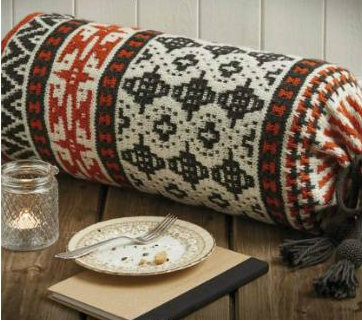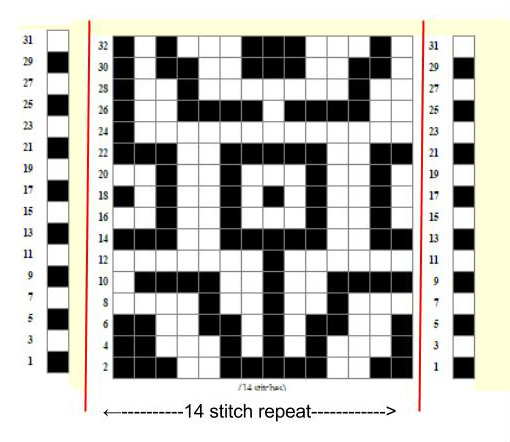
Mosaic knitting patterns use one of the easiest colorwork techniques you'll ever try as the patterns don't require working with strands and floats of yarn at the back of the work like Fair Isle.
You only ever work with one color yarn at a time, so there's no need to juggle multiple colors at once.
My knitting pattern the Marrakesh Bolster cushion which was featured in the UK magazine "The Knitter", issue 103. was made up of a series of mosaic patterns which I designed from scratch.
Knitting it up was a delight too. I chose slip stitch knitting (called mosaic knitting) because it knits up so quick, with no worries about the yarn strands on the other side of the work or the twisting of yarns whilst you knit.
I first attempted this lovely technique a year earlier. I was totally addicted to it for a while after buying Barbara Walkers Mosaic Knitting Book. You can buy it yourself here. Barbara's patterns intrigued me and I soon start developing a series of new original mosaic designs myself. I found they worked really well in cushions as I could just concentrate on the pattern rather than any garment shaping etc.
For you though I suggest that you take a look at this great intro to mosaic knitting , it shows you how to slip the stitches and links to some great patterns to get you started.
Or take a look at this web page which delves into mosaic knitting in some detail, comparing it to fair isle knitting and discussing the possibilities of adding texture to your work.
New ! Free Mosaic Charts and swatches
I've started devloping some simple mosaic charts that you can incorporate in to your own knits. All are 12 stitches wide by 12 rows (although this will measure more like 6 rows). Please use freely and let others know too.

I'll explain a little how mosaic slip stitch works using the funky flower pattern that is in my logo and in one of my cushions as an example
How to read the chart:-
Each row on the chart represents two rows of knitting, a right side row which is knitted and the following wrong side row which is purled. The right side row, beginning with an odd number at the right hand edge works from right to left. The wrong side row brings the same colour back to the right hand edge of the knitting. The other colour is left at the right hand side of the row waiting to be used later. The mosaic colour work is formed by slipping stitches (purlwise) so that the colour of the previous row is now included on the row you are working on. When slipping the stitches the working yarn should be held to the back of the work.
This is a 14 stitch repeat pattern, with an additional stitch at the beginning and the end of the row. So cast on 2 + (? x 14) stitches using cream yarn.
Try working the chart by following the instructions below
Row 1 : Use pink yarn and leave cream yarn dangling. Work from right to left of the chart Knit 1 *Knit 2, Slip 2, Knit 5, Slip 2, Knit 3;repeat from * to last stitch, Knit 1
Row 2 : Use pink yarn, this row is identical to row 1 but instead of knitting you purl, work from left to right of the chart. Purl 1, * Purl 3 , Slip 2, Purl 5, Slip 2 , Purl 2; repeat from * to last stitch , Purl 1
Row 3 : Use cream yarn and leave pink yarn dangling. Work from right to left of the chart Knit 1 *Slip 1, Knit 3, Slip 1, Knit 1, Slip 1, Knit 1, Slip 1, Knit 3, Slip 2;repeat from * to last stitch, Knit 1
Row 4 : Use cream yarn, this row is identical to row 1 but instead of knitting you purl, work from left to right of the chart. Purl 1, * Slip 2, Knit 3 , Slip 1, Purl 1, Slip 1 , Purl 1, Slip 1, Purl 3 , Slip 1; repeat from * to last stitch, Purl 1
After working a few rows you should find that you can easily just follow the chart.
The full funky flower cushion pattern can be found here. You get 3 patterns in 1 with this one as it also includes the honeypot and leaves mosaic patterns too.
Tips for Knitting Mosaic in the round - If you are knitting in the round, the selvedge stitches should be eliminated. Each color is still used for two rounds, but all chart rows are read from right to left, with the yarn held in back when slipping stitches. When changing colors at the beginning of the round, be sure to twist the yarns to avoid a hole at the join. Also, placing a marker at the beginning of the round is crucial. I think of it as a speed bump—it slows me down so I don’t go too far! Mosaic knitting does have some limitations. Unlike stranded knitting, a color can only appear in a row if there is a base color to pull up from below.

